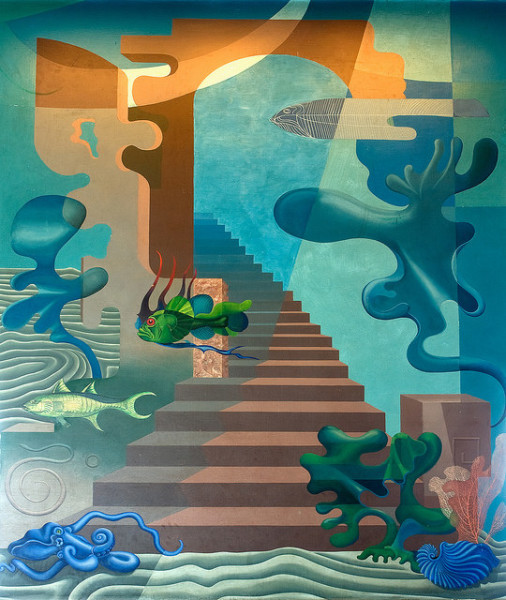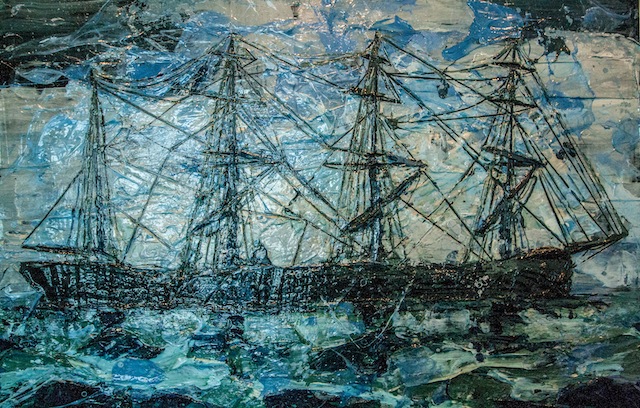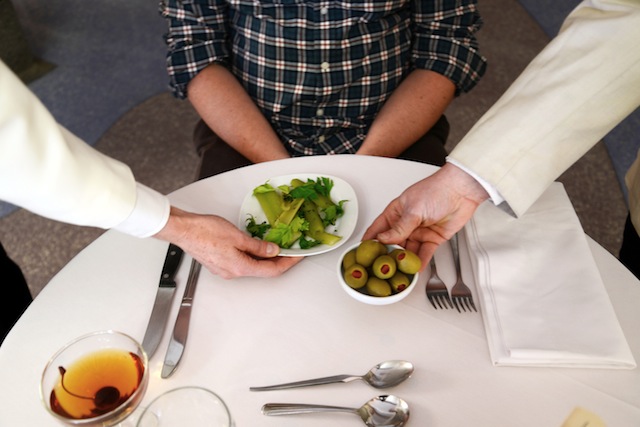On San Francisco’s north shore, just beyond Ghirardelli Square, sits the Aquatic Park Bathhouse. Part of the San Francisco Maritime National Historical Park, this Streamline Moderne building, which vaguely resembles a ship, overlooks a sandy cove, historic boats, Alcatraz Island and the Golden Gate. The architecture is modest, but it houses elaborate and alluring nautical art.
Opened in 1939, the bathhouse was built by the New Deal–era Works Progress Administration (WPA), who hired artists Hilaire Hiler, Sargent Claude Johnson and Beniamino Bufano to create murals, mosaics and sculptures for the site. Honoring this tradition of public art, We Players, a Bay Area theatre company committed to “site-integrated” performances, produced A New Deal: Continuing the Legacy of Maritime Art in the Park, an exhibit of conceptual art, painting, video and performance documentation.
We Players is most well known for their theater productions; Hamlet on Alcatraz and Macbeth at Fort Point. But visual arts has been a component of their work since a residency on Alcatraz, when they discovered an unused room and convinced park staff to let them to curate an exhibition there. Ava Roy, We Players’ artistic director and founder, says the visual arts programming operates as a companion to their theater productions. Such programming, she says, “provides another access point, especially for regular park visitors who aren’t going to encounter the full scale production.”

A New Deal is the first exhibition in a five-year partnership between the National Historical Park and We Players. While the WPA artists depicted fantastical Atlantis and pleasant representations of marine life, the eight contemporary artists in A New Deal address themes of militarism, violence and conflict in their work, interpreting the site and the city’s maritime history in a considerably different light.
Justin Carl Hurty presents an elusive multimedia installation about a man, Paul Smith, who may or may not exist. Smith is identified as a former naval pilot, vodka martini drinker and anti-communist. The centerpiece of the installation is a video of overlapping negative images in patriotic red, white and blue. In the video, fighter jets take off from an aircraft carrier and streak across the screen as crosshairs trace their paths. Sonar searches the ocean for threats as dolphins and whales swim in the sea. These scenes of naval violence are juxtaposed with the real-life sounds of children playing on the beach outside the bathhouse.

Painter Monica Lundy learned from the park’s archive of a notorious nineteenth-century ship called the May Flint, whose captain was often accused of cruelty. The ship itself was regarded as “the ugliest square rigger that ever sailed the seas” by maritime historian Basil Lubbock. The sole painting in A New Deal, Lundy’s May Flint (portrait of a hell ship) (2015) recreates the nightmarish ship in a thick and ghostly wood-panel painting that overlooks the actual site of the subject’s shipwreck in 1900, reminding viewers how vicious these waters once were. The sunny, circular Prismatorium room where most of the work is displayed creates a direct connection between the art and the site.
Soon after the bathhouse opened, the city leased much of the building to the Aquatic Park Casino, an exclusive restaurant. The private use of the space angered the WPA artists, who walked off the job — Johnson’s mosaic on the bathhouse’s veranda was never finished. Further controversy plagued the restaurant until went bankrupt in 1940.
The lack of information on this short-lived restaurant piqued the interest of interdisciplinary artist Torreya Cummings. Working with a chef, she researched and recreated the restaurant’s opening night menu, including broiled tenderloin steak aux champignon, consommé double, crab legs and jumbo olives. The meal was served by surly waiters to fellow A New Deal artist Matthew Gordon in a comic and deadpan reenactment of a historical footnote that once inflamed passions. This event is presented in the exhibition through documentation and ephemera. Of the indulgent meal, Cummings says, “I was thinking also about other food-based art projects that might begin as an accessible, utopian gesture, and end up as a dinner party for wealthy patrons.”

The WPA was an impossibly liberal social project by today’s standard, and many of the artists it employed were social activists, radicals and bohemians. Yet the original art at the Aquatic Park Bathhouse avoids any avert political message. Conversely, under a contemporary federal government prone to bouts of “culture war” and ideological defunding of the arts, contentious themes, including climate change and the 2010 Gaza flotilla raid, arise in A New Deal.
Patrick Gillespie, We Players’ visual arts director, notes that though the WPA work appears to avoid social commentary, “psychoanalysis, abstraction and fantasy were, to a certain degree, new ideas being integrated into artistic practice in the 1930s.” After seven decades, this may be difficult for some viewers to understand as radical. “What I find interesting,” he continues, “is that both generations were making art on the heels of significant social, political and environmental change. Ironically, seventy-five years later, those conditions have not improved and are in some cases much worse.”
The freedom to address these concerns in a state-owned setting is made possible by strong support from the park and its desire to encourage visitors to engage with the site’s history. Roy says the nature of their agreement with the park “allows us a great deal of spaciousness within our programming. Essentially it says that, philosophically, this National Park site and We Players are aligned, and it gives us greater space to experiment.”